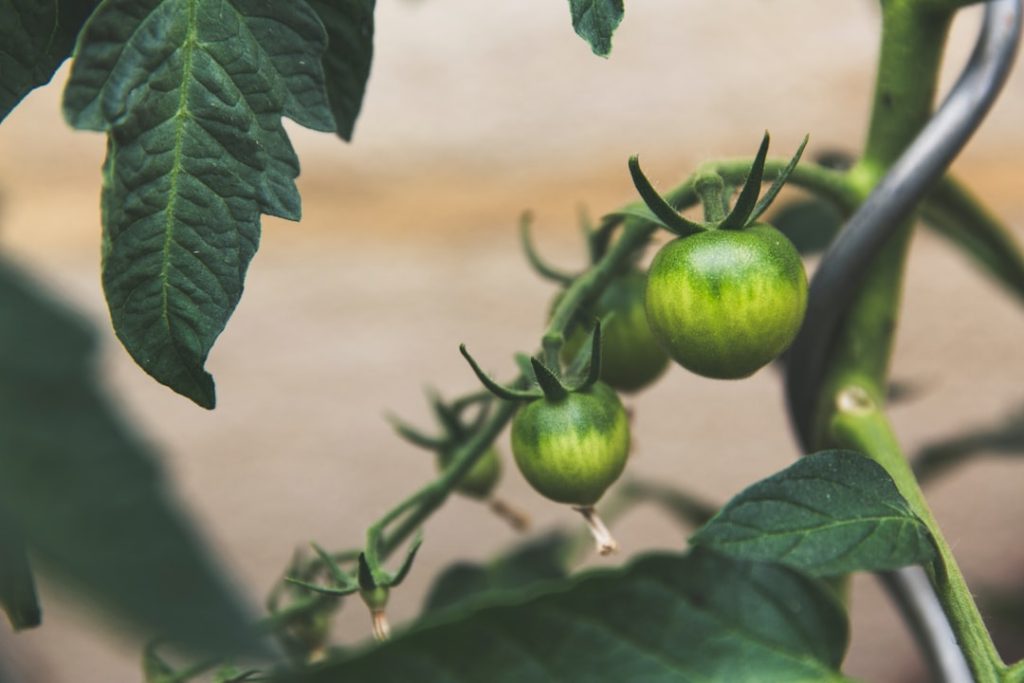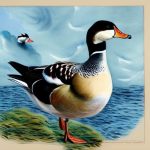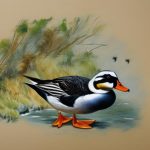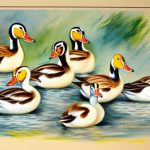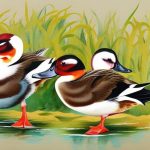Mallard ducks, scientifically known as Anas platyrhynchos, are one of the most recognizable and widespread duck species in the world. They are found in a variety of habitats, including wetlands, marshes, lakes, rivers, and coastal estuaries, making them a familiar sight to many people. The male mallard, also known as a drake, is easily identifiable by its vibrant green head, white neck ring, and chestnut-brown chest. The female, or hen, is more subtly colored with mottled brown plumage for camouflage. Mallards are known for their adaptability and can be found in urban parks and suburban ponds as well as in more natural settings.
Mallards are highly social birds and are often seen in large flocks, especially during the winter months when they gather in open water areas. They are also known for their distinctive quacking call, which is a common sound in wetland environments. Mallards are omnivorous and feed on a variety of plant matter, insects, and small fish. They are also dabbling ducks, meaning they tip forward in the water to feed rather than diving below the surface like some other duck species. Mallards are also popular game birds and are hunted for sport and food in many parts of the world. Despite this, they are considered a species of least concern by the International Union for Conservation of Nature (IUCN) due to their large and stable population.
Table of Contents
Key Takeaways
- Mallard ducks are a common species found throughout North America and Eurasia, known for their distinctive iridescent green heads and loud quacking calls.
- Breeding season for mallard ducks typically occurs in the spring, and males engage in elaborate courtship displays to attract females.
- Female mallard ducks build their nests on the ground, often near water, and lay an average of 8-13 eggs in a clutch.
- After an incubation period of about 4 weeks, the ducklings hatch and are immediately led to water by the mother to begin foraging for food.
- Mallard duck breeding faces threats from habitat loss, predation, and human disturbance, but conservation efforts such as habitat protection and nest box programs are helping to support their populations.
Breeding Season and Behavior
Mallards typically breed in the spring and summer months, with the breeding season varying depending on the geographic location. In more temperate regions, such as North America and Europe, breeding occurs from March to May, while in more southern areas breeding can occur year-round. During the breeding season, male mallards engage in elaborate courtship displays to attract females. These displays often involve the males bobbing their heads, flapping their wings, and making a series of calls to impress potential mates. Once a pair has formed, they will engage in a series of behaviors to strengthen their bond, including preening each other’s feathers and engaging in synchronized swimming.
Mallards are monogamous for the duration of the breeding season, but they will often find new mates in subsequent years. The females are responsible for building the nest and incubating the eggs, while the males will guard the nesting area and keep watch for potential predators. Mallards are known for their aggressive defense of their nesting territory and will fiercely protect their eggs and young from any perceived threats. Once the eggs have hatched, both parents will take an active role in caring for the ducklings, teaching them how to find food and providing protection from predators.
Nesting Habits and Egg-laying
Mallard ducks typically build their nests on the ground in a concealed location near water, such as in tall grasses or under shrubs. The female will construct the nest using grasses, reeds, and other plant materials, lining it with down feathers from her own body to provide insulation for the eggs. The nests are often well-hidden to protect them from predators such as raccoons, foxes, and birds of prey. Mallards are known for their adaptability when it comes to nesting sites and will sometimes even nest in urban environments, such as in flower beds or on balconies.
The female mallard will lay a clutch of 8-13 eggs over a period of about 2 weeks, laying one egg per day. The eggs are a pale greenish color and are about the size of a large chicken egg. Once all the eggs have been laid, the female will begin incubating them to keep them warm and facilitate development. Incubation typically lasts for 26-30 days, during which time the female will rarely leave the nest except to feed briefly. The male will stand guard nearby and may occasionally bring food to the female to sustain her during this time.
Incubation and Hatching
Incubation is a critical time for mallard eggs, as they must be kept at a consistent temperature and humidity level for proper development. The female mallard accomplishes this by sitting on the eggs and rotating them regularly to ensure even heat distribution. She also plucks down feathers from her breast to line the nest and provide additional insulation for the eggs. During this time, the female will also turn the eggs periodically to prevent the embryos from sticking to the shell membrane.
After about a month of careful incubation, the eggs will begin to hatch. The ducklings use a specialized egg tooth on their bill to break through the shell, a process that can take several hours. Once hatched, the ducklings are covered in down feathers and are able to walk and swim within hours. They are born with their eyes open and are immediately able to follow their mother as she leads them to water to begin feeding.
Parental Care and Duckling Development
Once the ducklings have hatched, both parents play an active role in caring for them. The female will lead her brood to water shortly after hatching, where the ducklings will begin feeding on insects, small fish, and plant matter. The male will continue to guard the nesting area and may also help protect the ducklings from predators as they explore their new environment.
Mallard ducklings grow rapidly and will double their weight within the first week of life. They are precocial birds, meaning they are born with their eyes open and are able to feed themselves shortly after hatching. The parents will continue to provide protection and guidance for the ducklings as they learn important survival skills such as finding food and avoiding predators. Mallard ducklings will stay with their parents for about 2 months before they become independent and begin to migrate with other ducks.
Threats to Mallard Duck Breeding

Despite their adaptability and large population size, mallard ducks face a number of threats to their breeding success. Habitat loss is a major concern for mallards, as wetlands and other natural areas are increasingly being developed for agriculture and urbanization. This loss of habitat can disrupt nesting sites and reduce food sources for mallards, making it more difficult for them to successfully raise their young.
Predation is another significant threat to mallard breeding success. Nest predation by mammals such as raccoons and foxes can significantly reduce nest success rates, while predation on ducklings by birds of prey and other predators can also take a toll on mallard populations. Climate change is also a concern for mallards, as it can alter the timing of breeding seasons and affect food availability for ducklings.
Conservation Efforts and Management
Conservation efforts for mallard ducks focus on protecting and restoring wetland habitats, which are critical for breeding success. This includes creating protected areas such as national wildlife refuges and wetland reserves where mallards can nest undisturbed. Habitat restoration projects aim to reestablish wetland areas that have been lost or degraded due to human activities.
In addition to habitat protection, predator management programs may be implemented to reduce nest predation rates and protect ducklings from predators. These programs often involve trapping or relocating predators that pose a threat to mallard breeding success.
Public education and outreach programs also play a role in mallard conservation efforts by raising awareness about the importance of wetland habitats and the threats facing mallard populations. By engaging local communities in conservation efforts, it is possible to foster support for protecting mallards and their habitats for future generations.
In conclusion, mallard ducks are fascinating birds with unique breeding behaviors and challenges. By understanding their nesting habits, incubation process, parental care, and threats they face, we can work towards conserving these iconic waterfowl for generations to come. Through habitat protection, predator management, and public education efforts, we can ensure that mallards continue to thrive in their diverse range of habitats around the world.
If you’re interested in learning more about mallard duck breeding facts, you might also want to check out this informative article on where to put a chicken coop. Understanding the best location for a coop can be crucial for the health and well-being of your poultry, just as it is for ducks. Both ducks and chickens require suitable housing to thrive, so it’s worth exploring the various aspects of coop placement.
FAQs
What is the breeding season for mallard ducks?
The breeding season for mallard ducks typically occurs in the spring and early summer, with peak breeding activity occurring between March and June.
How do mallard ducks choose a mate?
Mallard ducks engage in courtship displays, with males performing various behaviors to attract females. Once a pair bond is formed, the male and female will mate and the female will begin to build a nest.
Where do mallard ducks build their nests?
Mallard ducks build their nests on the ground, typically in grassy areas near water. The female lines the nest with down feathers to provide insulation for the eggs.
How many eggs do mallard ducks lay?
Mallard ducks typically lay 8-13 eggs in a single clutch, although larger clutches have been observed. The eggs are incubated for about 26-30 days before hatching.
Do mallard ducks mate for life?
Mallard ducks are not strictly monogamous and do not mate for life. However, they often form pair bonds that last for the duration of the breeding season.
How long do mallard ducklings stay with their mother?
Mallard ducklings stay with their mother for about 50-60 days after hatching. During this time, the mother provides protection and guidance as the ducklings learn to forage and navigate their environment.
Meet Walter, the feathered-friend fanatic of Florida! Nestled in the sunshine state, Walter struts through life with his feathered companions, clucking his way to happiness. With a coop that’s fancier than a five-star hotel, he’s the Don Juan of the chicken world. When he’s not teaching his hens to do the cha-cha, you’ll find him in a heated debate with his prized rooster, Sir Clucks-a-Lot. Walter’s poultry passion is no yolk; he’s the sunny-side-up guy you never knew you needed in your flock of friends!

